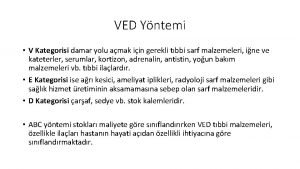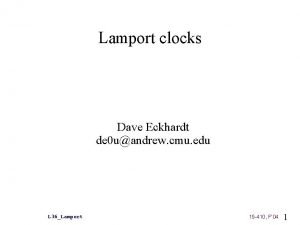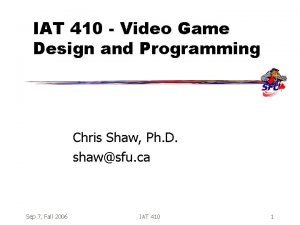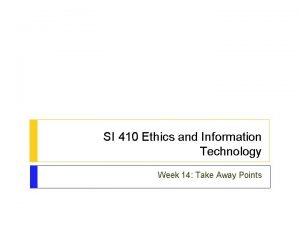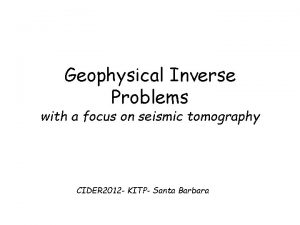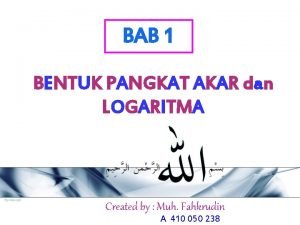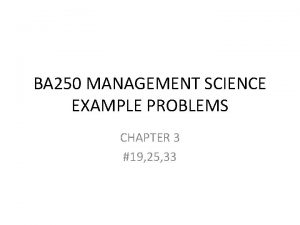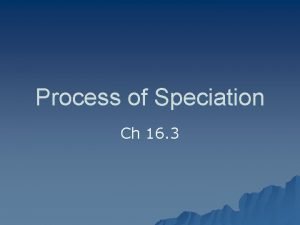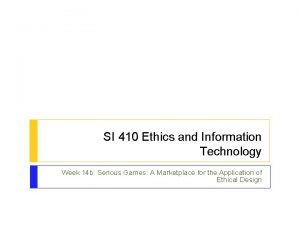Data Structures and Analysis COMP 410 David Stotts
















- Slides: 16

Data Structures and Analysis (COMP 410) David Stotts Computer Science Department UNC Chapel Hill

Blockchain as a data structure

Cryptocurrencies � Digital medium of exchange (not tangible) � Bitcoin is (not) the first and is most famous (Aug. 2008) ◦ Bitcoin based on Hashcash � Dozens out there now, termed “Altcoins” ◦ Litecoin, Bytecoin, BC Cash, Ripple, Monero, Nexus … ◦ Kodakoin (company/industry specific)

Cryptocurrencies � Traded on exchanges like stocks (and like tangible currencies) � Are cryptocurrencies used? ◦ Some vendors accept them ◦ Many governments are mulling over outlawing or regulating them � Private parties can use bitcoin… since the ledger is public, and open, and secure � So it is more than barter (due to exchanges)

Cryptocurrencies and Blockchain � Bitcoin and blockchain are not the same thing � Like claiming the voter registration records and Relational DB technology are the same thing � Bitcoin (and other many other Altcoins) are implemented on a blockchain � Blockchain is being used for many applications others than digital currencies now as well

Blockchain features Blockchain technology is ◦ ◦ ◦ database distributed tamper-proof no central control sequential (temporal) record trace � Database ◦ ledger for financial transactions in the coin ◦ records who gains wealth (mines) ◦ records who transfers how much to whom

Cryptocurrencies � Tamper proof ◦ security via encryption ◦ security via replication � No central control ◦ open software ◦ run your own copy of the Bitcoin software (mine, use) � Distributed ◦ many copies of the chain exist world-wide ◦ survives many local failure events (flood, fire, willful destruction, computer outage, etc. ) ◦ every computer in the network has a copy (almost)

How blockchain works � Chain of blocks ( surprise ! ) � Block is an encrypted collection of data (in general) ◦ For Bitcoin, that data is financial transaction info � Each block has a “digital fingerprint”, a hash value � Each block contains (and encodes) the hash of its previous block in chain, and next in chain ◦ In COMP 410 terms, a blockchain is a doubly linked list

Hashing in security � Hashing used for encryption and security (not access into a hash table) � We want a hash to be a “fingerprint” of some data ◦ we want the fingerprint to be unique ◦ want fingerprint to be fixed size no matter the data size � If d. A !== d. B (even a little different) we want ◦ hash(d. A) !== hash(d. B) ◦ hash(d. A) is VERY different from hash(d. B) so we cant guess hash(d. B) if we know d. A and hash(d. A)

SHA-256 Hash � SHA (Secure Hash Algorithm) is a collection of related cryptographic hash functions � SHA-256 generates an almost-unique, fixed size 256 -bit (32 -byte) hash �a one way function – it cannot be decrypted back � How many 256 bit values are there? 2^256 ◦ this is 1. 158 x 10^77 ◦ compare 10^80 atoms in the known universe Try it online

Who loves large numbers? � How many different possible NCAA brackets are there? ◦ Let’s say in 64 teams even… 2^63 … 9, 223, 372, 036, 854, 775, 808 ◦ 9. 2 quintillion (sounds big but how big? ) How big? � How many different card shuffles? ◦ 52 ! which is 8. 0658175 e+67 ◦ Total atoms in the galaxy? 10^68

Data Structure Blockchain is a doubly-linked list chain head (block 0000) Financial transaction information next prev X prev A “link” also is SHA 256 hash of the block With a special condition Financial transaction information next prev Financial transaction information next Watch this explanation prev X

Mining � Every ten minutes, one lucky Bitcoin miner earns a reward for extending the block chain by one block. � In 2009, the reward was 50 BTC. Today it is 12. 5 BTC. (See https: //blockchain. info/q to issue queries about the block chain. ) � Mining is the only mechanism for creating new bitcoins. The total number of Bitcoins will never exceed 21 M. � The rewarded miner also receives all (optional) transaction fees in the block. � Smallest division of a bitcoin is a Satoshi, 1/100 th of a millionth of a Bitcoin ( 0. 00000001 of a BTC )

Mining � Mining costs electricity and hardware � My computer will do about 220, 000 SHA-256 encryptions per second � Mining “rigs” in common use do about 2. 2 billion SHA-256 hashes per second � So my laptop does 2. 2 g. Hashes in 2. 77 hours � One mining rig does the work of 10, 000 of my laptops � So, I can mine bitcoins on my laptop if I wish… there is a chance my snail-paced miner will luckily hit a good block hash � BUT that chance is like winning the Powerball lottery

Speed of hashing � Look at average #hashes must be done to mine a block � Demo in Java. Script how many SHA-256 can do per sec � My laptop does 10 million per minute � 1 million per 6 seconds, is ~170000 per second � Measure � Mining 220000 per second rigs do 2. 2 g. Hashes per sec to find a new block every 10 minutes

END Beyond this is just templates



